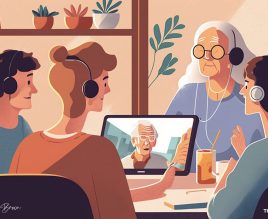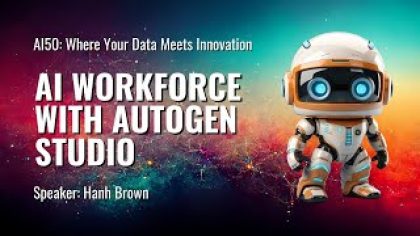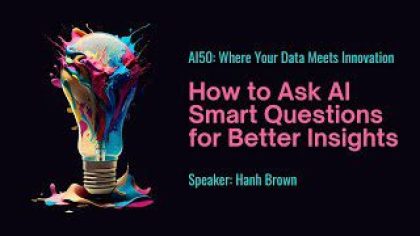Table of Contents
ToggleAs the global population ages, the importance of strong communities for seniors’ well-being and mental health cannot be overstated. Access to resources and social connections play a crucial role in ensuring life satisfaction during the golden years. In recent years, artificial intelligence (AI) has emerged as a powerful tool in helping seniors access resources and forge social connections while simultaneously posing challenges in terms of unequal access and the digital divide.
In this article, we will explore how AI can help in connecting seniors to resources and personalized suggestions to seniors, connecting them to local services and programs tailored to their needs. We’ll delve into the role of AI in community building and social connections, examining AI-powered social networking platforms and virtual assistants. We’ll also discuss strategies for bridging the digital divide and overcoming technological barriers faced by seniors, along with digital literacy programs and initiatives.
Through real-life examples and anecdotes, we’ll illustrate the impact of AI on seniors’ lives and consider the implications and future developments in this area, with an emphasis on the potential of AI in addressing social isolation and resource accessibility. Lastly, we’ll address frequently asked questions and provide supplementary resources and references for further exploration.
AI-Driven Resource Recommendations

AI’s potential to enhance seniors’ lives includes providing personalized resources and fostering connections to local services. This section delves into AI’s ability to offer tailored recommendations for seniors, enabling them to access essential resources and programs that cater to their specific needs and preferences.
AI in Connecting Seniors to Personalized Resource
AI-driven resource recommendations can revolutionize the way seniors access and engage with resources essential to their well-being. Machine learning algorithms can analyze an individual’s health status, interests, and personal preferences to provide targeted suggestions for relevant resources.
For example, AI can recommend exercise routines suitable for seniors with specific physical limitations, ensuring they stay active without risking injury. AI-driven meal planning apps can offer personalized nutrition advice, accommodating dietary restrictions and preferences while promoting a balanced diet tailored to seniors’ health requirements.
In terms of mental health, AI can suggest mindfulness exercises, relaxation techniques, or hobby ideas based on a senior’s interests and cognitive capabilities. These personalized recommendations contribute to seniors’ overall well-being, fostering a sense of meaning and purpose in their lives.
Furthermore, AI can also help seniors manage their finances more effectively by recommending budgeting strategies, optimizing investment portfolios, and identifying potential savings. By addressing these essential aspects of seniors’ lives, AI-driven resource recommendations can promote independence and life satisfaction during their golden years.
Connecting Seniors to Local Services and Programs
AI has the potential to help seniors tap into local services and programs in their communities more easily. By analyzing data on available community services, such as senior centers, meal delivery programs, transportation services, and support groups, AI can match seniors with resources that best fit their needs and preferences.
For instance, AI can identify senior-friendly transportation options based on an individual’s mobility constraints, enabling them to attend medical appointments or social events with ease. Similarly, AI can recommend local support groups or social clubs based on seniors’ interests, facilitating social connections and reducing the risk of isolation.
Moreover, AI-driven platforms can connect seniors with volunteer opportunities or community events, fostering a sense of belonging and purpose. By actively participating in their communities, seniors can not only maintain their mental health but also contribute to building strong, vibrant neighborhoods.
In cases where seniors require home-based support services, AI can assist in identifying suitable providers in their area, such as in-home caregivers, healthcare professionals, or home maintenance services. This ensures seniors receive the support they need to age in place comfortably while also promoting their independence and well-being.
In summary, AI-driven resource recommendations can enhance seniors’ lives by providing personalized suggestions and connecting them to local services and programs. By leveraging AI, we can work towards building strong communities that cater to the unique needs and preferences of older adults.
Also read: AI in Managing Chronic Conditions and Multiple Medications
AI in Community Building and Social Connections

Artificial intelligence can play a significant role in community building and fostering social connections among seniors. This section will discuss how AI-powered social networking platforms and virtual assistants can promote social engagement and help seniors build strong, supportive communities.
AI-Powered Social Networking Platforms
AI-powered social networking platforms can revolutionize the way seniors connect with others, both within their local communities and beyond. These platforms can use AI algorithms to analyze seniors’ interests, hobbies, and backgrounds, allowing them to match users with like-minded individuals and groups.
By facilitating connections based on shared interests and experiences, AI-powered social networking platforms can help seniors forge meaningful relationships, reducing the risk of social isolation and loneliness. These platforms can also offer features specifically designed for seniors, such as larger text sizes, simplified navigation, and voice commands, making them more accessible and user-friendly.
Additionally, AI can be used to identify and flag inappropriate content or potential scammers, ensuring a safe online environment for seniors. AI can also analyze user interactions and provide suggestions for conversation starters or group activities, further promoting social engagement among seniors.
Virtual Assistants and Social Engagement
Virtual assistants, powered by AI, can contribute to seniors’ social engagement in various ways. These assistants can help seniors schedule and manage social activities, send reminders for events, and even provide transportation options to ensure they stay connected with their community. By offering companionship and conversation, virtual assistants can help alleviate feelings of loneliness and isolation among seniors.
AI-powered chatbots can engage in natural language conversations with seniors, discussing their interests, sharing news updates, or even telling jokes, providing a sense of companionship and mental stimulation. Furthermore, virtual assistants can assist seniors in staying connected with their families and friends by helping them navigate communication apps, such as video calls or messaging services. This enables seniors to maintain and strengthen their relationships, even if they’re physically distant from their loved ones.
Some virtual assistants are also equipped with emotion recognition capabilities, enabling them to detect seniors’ emotional states and respond accordingly. For instance, if the AI detects signs of sadness or anxiety, it may suggest relaxation techniques, recommend a favorite playlist, or encourage the senior to reach out to a friend for support.
Overall, AI-powered social networking platforms and virtual assistants can significantly enhance seniors’ social engagement and contribute to building strong, supportive communities. By leveraging AI technology, we can help seniors stay connected and maintain their well-being in the face of an increasingly digital world.
Bridging the Digital Divide for Seniors

While AI offers numerous opportunities to enhance seniors’ lives, it is essential to address the digital divide that exists among older adults. This section will explore strategies for overcoming technological barriers faced by seniors and discuss digital literacy programs and initiatives designed to bridge the gap.
Overcoming Technological Barriers
To ensure that all seniors can benefit from AI-driven solutions, it is crucial to address the various technological barriers they may encounter. Some common challenges faced by seniors when adopting new technologies include limited access to devices, internet connectivity issues, physical impairments, and the complexity of user interfaces.
To tackle these barriers, it is essential to provide affordable access to technology. This can be achieved through initiatives like subsidized devices and internet plans, or by partnering with local libraries and community centers to offer public access to computers and Wi-Fi.
Furthermore, developers should prioritize creating senior-friendly user interfaces with features such as larger text sizes, simplified menus, and voice command capabilities. Designing technology with seniors in mind will make it more accessible and appealing, encouraging broader adoption.
In cases where physical impairments pose a challenge, adaptive technology and assistive devices can help seniors overcome limitations. For instance, speech-to-text software, screen readers, or specialized keyboards can enable seniors with vision, hearing, or mobility impairments to engage with technology more comfortably.
Digital Literacy Programs and Initiatives
Digital literacy programs and initiatives can play a vital role in bridging the digital divide for seniors. These programs aim to equip older adults with the knowledge and skills needed to confidently navigate the digital world, making the most of AI-driven solutions.
Community organizations, libraries, and senior centers can offer digital literacy courses specifically designed for older adults. These courses should cover essential topics such as basic computer skills, internet navigation, online safety, and an introduction to AI technologies like virtual assistants and social networking platforms.
In addition to formal training, peer mentoring programs can be an effective way to support seniors in their digital literacy journey. Pairing tech-savvy seniors with those who are less experienced can foster a supportive learning environment where older adults can share their knowledge, experiences, and tips for overcoming challenges.
Finally, engaging family members and caregivers in seniors’ digital literacy education is crucial. By providing them with the tools and resources to support their loved ones, they can play an active role in helping seniors navigate the digital world and benefit from AI-driven solutions.
By addressing technological barriers and promoting digital literacy among seniors, we can work towards bridging the digital divide and ensuring that all older adults can access the benefits of AI-driven resource recommendations, community building, and social connections.
Real-Life Examples and Anecdotes
To truly understand the impact of AI on seniors’ lives, it’s crucial to examine real-life examples and anecdotes that showcase the benefits of AI-driven resource recommendations, AI-powered social platforms, and successful digital literacy programs. In this expanded section, we’ll delve deeper into these areas, exploring various case studies and personal stories that illustrate how AI can significantly improve the quality of life for older adults.
A senior benefiting from AI-driven resource recommendations
Meet Jane, a 72-year-old retiree who suffers from arthritis. Through an AI-driven health app, Jane receives personalized exercise routines specifically designed for individuals with arthritis, helping her stay active without exacerbating her condition. The app also suggests local support groups for arthritis sufferers, enabling Jane to connect with others facing similar challenges and learn about new treatment options.
AI-powered social platforms connecting seniors in a community
Connect2Affect, a groundbreaking initiative by the AARP Foundation, harnesses the power of AI to connect people with social engagement opportunities in their communities. By analyzing the interests, needs, and preferences of seniors, this innovative platform can recommend local events, clubs, and services tailored to each individual’s unique situation.
A successful digital literacy program for older adults
Cyber-Seniors, a non-profit organization, has implemented a successful digital literacy program for older adults. Through their intergenerational mentorship model, Cyber-Seniors pairs young volunteers with seniors to teach them essential digital skills. This program has helped thousands of seniors learn how to use technology effectively, enabling them to stay connected with family and friends, access online resources, and participate in virtual events
These real-world examples demonstrate the potential of AI and digital technology in improving seniors’ lives by connecting them to essential resources, promoting social engagement, and providing digital literacy education.
Implications and Future Developments: Expanding the Scope

As AI continues to advance, its potential to improve seniors’ lives becomes increasingly evident. In this expanded section, we will delve deeper into the potential of AI in addressing social isolation and resource accessibility, as well as the ongoing challenge of ensuring equal access to AI solutions for all seniors. We will also explore the role of AI in enhancing senior healthcare and discuss the importance of intergenerational collaboration in AI development.
The Potential of AI in Addressing Social Isolation and Resource Accessibility
AI has immense potential to combat social isolation and enhance resource accessibility among seniors. By providing personalized resource recommendations, AI can help seniors maintain their physical, mental, and emotional well-being, fostering a sense of purpose and fulfillment. AI-powered social platforms can connect seniors with like-minded individuals, reducing loneliness and promoting a sense of belonging within their communities. These platforms can also facilitate the organization of local events and activities, encouraging seniors to participate in social gatherings and develop new friendships.
Furthermore, AI can help seniors navigate local services and programs more effectively, enabling them to access essential resources and support. As AI technology evolves, it is likely that these platforms will become even more sophisticated, offering increasingly accurate and personalized recommendations, as well as fostering deeper connections among seniors. AI-driven virtual assistants and home automation systems can also support seniors in their day-to-day lives, assisting with tasks such as medication management, appointment scheduling, and transportation. These solutions can also be tailored to provide real-time health monitoring and reminders, ensuring that seniors maintain their well-being and adhere to their healthcare routines.
The Role of AI in Enhancing Senior Healthcare
AI has the potential to revolutionize senior healthcare, enabling more accurate diagnoses and personalized treatment plans. By leveraging data from wearable devices and electronic health records, AI can detect patterns and anomalies, allowing healthcare professionals to identify potential health risks early and intervene proactively. AI-driven telemedicine platforms can also facilitate remote consultations, ensuring that seniors receive timely medical attention without the need to travel. This is particularly valuable for seniors living in rural or underserved areas, where access to healthcare services may be limited.
The Importance of Intergenerational Collaboration in AI Development
In order to develop AI solutions that truly meet the needs of seniors, it is crucial to involve seniors and their caregivers in the development process. By fostering intergenerational collaboration, we can ensure that AI technologies are designed with empathy, understanding, and respect for the unique challenges faced by seniors. This collaboration can also help bridge the generational gap and promote a deeper understanding of the potential benefits and limitations of AI among different age groups.
The Ongoing Challenge of Ensuring Equal Access to AI Solutions
Despite the potential benefits of AI, ensuring equal access to AI solutions remains a significant challenge. Bridging the digital divide requires concerted efforts from various stakeholders, including government agencies, technology developers, community organizations, and family members. By addressing technological barriers and promoting digital literacy among seniors, we can work towards achieving greater equity in access to AI-driven solutions.
Future developments in AI should also focus on creating more inclusive and accessible technologies, considering the diverse needs and preferences of seniors. This includes designing user interfaces that accommodate age-related limitations and incorporating adaptive technologies for those with physical impairments. Additionally, it is essential to consider potential ethical concerns and biases that may arise in the development and deployment of AI technologies, ensuring that these solutions are fair and unbiased for all users.
By working together to address these challenges, we can harness the power of AI to improve the lives of seniors, fostering greater independence, well-being, and social connection.
Conclusion
AI has the potential to revolutionize the way seniors access resources, connect with others, and participate in their communities. By providing personalized resource recommendations, fostering social connections through AI-powered platforms, and bridging the digital divide, we can build stronger communities that cater to the unique needs of older adults.
Key insights and takeaways include the importance of addressing technological barriers and promoting digital literacy among seniors to ensure equal access to AI solutions. Additionally, ongoing collaboration among various stakeholders is crucial to creating a more inclusive and accessible digital landscape for seniors.
As technology continues to advance, embracing the potential of AI in community building will become increasingly important. By leveraging AI-driven solutions, we can support seniors in living fulfilling, connected lives, ultimately enhancing their well-being and life satisfaction during their golden years. Emphasizing inclusivity and accessibility in AI development will ensure that all seniors, regardless of their abilities or background, can benefit from these transformative technologies.
FAQs
How can AI help seniors access resources and services?
AI can help seniors access resources and services by providing personalized recommendations based on their interests, needs, and location. This can include healthcare services, social groups, financial support, and educational opportunities, allowing seniors to make informed decisions and improve their quality of life.
What are the challenges faced by seniors in adopting AI technology?
Challenges faced by seniors in adopting AI technology include limited access to devices, internet connectivity issues, physical impairments, and complex user interfaces. Additionally, a lack of digital literacy may hinder seniors from making the most of AI-driven solutions.
How can the digital divide be addressed for seniors?
The digital divide can be addressed for seniors through initiatives that provide affordable access to technology, offer digital literacy programs, create senior-friendly user interfaces, and develop adaptive technologies for those with physical impairments.
Are there any potential drawbacks to AI-driven resource recommendations?
AI-driven resource recommendations for seniors have notable drawbacks, including potential inaccuracy from insufficient data or flawed algorithms, privacy concerns arising from sensitive personal data usage, and overreliance on technology leading to reduced human interaction.
How can communities ensure equal access to AI solutions for seniors?
Communities can ensure equal access to AI solutions for seniors by addressing technological barriers, promoting digital literacy, collaborating with various stakeholders, and developing inclusive and accessible AI technologies that cater to the diverse needs of older adults.
What role can caregivers and family members play in supporting seniors’ use of AI technology?
Caregivers and family members can support seniors’ use of AI technology by assisting them in accessing devices and internet services, providing guidance and encouragement, participating in digital literacy education, and advocating for inclusive and accessible AI solutions.
References
- https://www.sciencedirect.com
- https://seniornet.org
- https://mylifesite.net
- https://www.nationalacademies.org


















2 Comments
[…] prevent the exclusion of seniors who are less digitally connected. It is important to invest in digital literacy programs, affordable internet access, and […]
[…] it’s strategic games, puzzles, or trivia, the internet is brimming with online gaming options that can sharpen your mind while you socialize. Interactive games on platforms like Pogo or […]